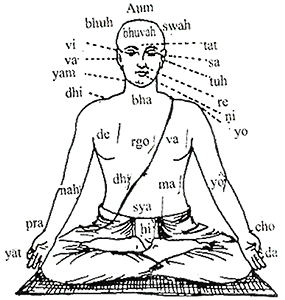
Mantras
A mantra is a specific set of sounds that resonantly influences certain parts of the brain and body.
Etymology of the word «mantra»
Literal translation: A mantra is an «instrument (or place) of thinking».
The purpose of a mantra is to awaken within oneself a chosen psychological state or feeling associated with the mantra.
Influence of mantras on an individual
Neuropsychological
Resonant
Connection between sounds and chakras: Tantric approach
Such a connection is described in many primary sources, where chakras are mentioned (such as Chakra-kaumudi, Yoga-vishaya, Shat-chakra-nirupana, and others).
This implies that not only pronunciation of words is closely connected to actions and states, but also pronunciation of sounds is linked to certain feelings.
Techniques for performing mantras
Indian Tradition
2nd level: The mantra is chanted in a whisper, but with distinct articulation.
3rd level: The mantra is chanted mentally, without vocalizing it.
4th level: The mantra is not chanted externally, but the person invokes the corresponding state associated with the mantra.
Other Traditions
Tibetan
Japanese
Mantras «hamsa» and «soham»
Performing pranayama (or asanas) with mantra
However, direct mention of such practice was found in the Mrigendra Tantra, where this type of pranayama is called «sa-garbha pranayama», in contrast to «nir-garbhi», which is regular. By the way, the word «garbha» means «embryo», so pranayamas can be practiced with an embryo or without.
The main effect of sa-garbha pranayama, according to the author of the Mrigendra Tantra, is the concentration of consciousness (chitta) and purification from spiritual impurities. Thus, verses 29-30 recommend performing this pranayama at sunrise to cleanse oneself from sins committed during the night and at sunset to cleanse oneself from the consequences of daily activities.
Listening to the sounds created by the air during inhalation and exhalation
• The air inhaled by a person creates the sound «so».
• The exhaled air creates the sound «ham».
The «ham-sa» mantra
• The air inhaled by a person creates the sound «ham».
• The exhaled air creates the sound «sa».
The «japa» mantra
Regarding such practice, one of the earliest grammarians, Yaska (6th–7th century BCE), wrote: «Reciting mantras without understanding their essence is the same as offering sacrifices to extinguished embers rather than to the fire».
In the context of classical yoga, «japa» is a special practice of repeating mantras with deep textual analysis. This term has undergone significant changes in its meaning compared to its original sense. However, regardless of the context, «japa» involves the verbalization of mantras. A mantra is a unique energetic text. But for a holistic person, what they say is always energetic because they are sincere and do not speak unnecessarily. Similar to a poetic work that, even though written by a person, becomes a source of inspiration for many through quotations, mantras are also initially recited by individuals experiencing higher states of consciousness, and then they are used by those who are striving for such states.
«Yoga: History of Ideas and Views», Chapter 4 «Yoga as Union»
Japa in the Mrigendra Tantra
You can understand this by recalling the state when you seem to have captured the essence of a certain insight but cannot verbalize it accurately. Then you try to do so by uttering it many times using different words (paraphrasing method). Another example is the ability to elaborate on a thought, explaining it multiple times to a conversational partner.
Surya Namaskar mantras
For example, the sixth mantra of the complex:
Greetings to the Sun, the nourisher!
References to mantras in primary sources
Pashupata Sutra
through offerings such as laughter, dancing,
clapping, greetings, and recitation of mantras.
Yoga Sutra
tasya vācakaḥ praṇavaḥ || 1.27 || tajjapastadarthabhāvanam || 1.28||
Yoga Marga Prakasika
Here is the description of Mantra Yoga:
12. Let the wise ones, during exhalation, pronounce the sound HA, then during inhalation, the sound SA.
13. Rising at dawn, the knowledgeable yogi, abiding by the rules that determine the intentions, practices mantra yoga according to the instructions of the teacher.
14. Therefore, gradually practice, not forgetting during day or night. Having realized the «sohamatma», let them think of nothing else.
The Hymn of Abhinavagupta
saṃsthānaṃ sukha-duḥkha-janma-vapuṣo yat kāpi mudraiva sā |
prāṇasya svarasena yat-pravahaṇaṃ yogaḥ sa evādbhutaḥ
śāktaṃ dhāma paraṃ mamānubhavataḥ, kinnāma na bhrājate ॥ 3॥
The position of his body, associated with birth, pleasure, suffering (i.e., the physical body), is wise.
His natural breath is a marvelous yoga.
After experiencing this magnificent, powerful, radiant state, what will not be illuminated?
Perception of mantras beyond the scope of yoga
Religious performance of mantras
This refers to the kind of execution that is not a practice of yoga, for example, repeating a mantra like a prayer (without knowing its meaning and without aiming for any state that the mantra evokes).
Another approach to performing mantras can be attributed to a religious perspective — a magical perception of mantras, where the words of the mantra are treated as those that fulfill the practitioner’s desires.
Mantras as incantations
Mantras as incantations are mentioned in the Goraksha Paddhati.
Goraksha Paddhati
agrāhyo mantra-yantrāṇāṃ yogī yuktaḥ samādhinā ॥2.89॥
is invulnerable to all types of weapons, cannot be killed by humans,
and is immune to mantras and yantras.
